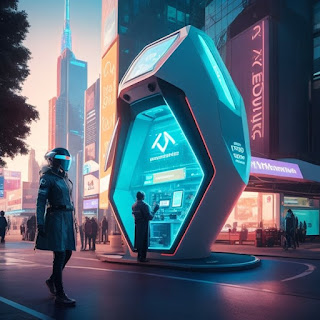Unleashing Creative Marketing: Harnessing Virtual and Augmented Reality.
By Laurie Suarez www.crypto101bylauriesuarez.com
Introduction
In the realm of marketing, innovation is key to capturing
the attention of today's tech-savvy consumers. Virtual Reality (VR) and
Augmented Reality (AR) have emerged as groundbreaking technologies that have
transformed the way brands engage with their audiences. By adopting VR and AR
for marketing, businesses can create immersive experiences that captivate and
resonate with consumers on a whole new level. In this blog, we will explore the
benefits of incorporating VR and AR into marketing strategies, discuss
real-world use cases, and highlight the potential of these technologies to revolutionize
the way brands connect with their target audiences.
The Power of VR and AR in Marketing
1.
Immersive Engagement: VR and AR
provide immersive experiences that captivate consumers, enhancing their
engagement with the brand.
2.
Interactive Storytelling: These
technologies enable brands to tell stories in dynamic and interactive ways,
fostering deeper connections with audiences.
3.
Enhanced Product Visualization:
VR and AR allow consumers to visualize products in real-world settings before
making a purchase decision.
4.
Brand Differentiation: Brands
that embrace VR and AR stand out as innovative and forward-thinking, attracting
tech-savvy consumers.
5.
Data-Driven Insights: These
technologies gather valuable data on consumer interactions, helping brands
refine their strategies for better results.
Real-World Use Cases of VR and AR in Marketing
1.
Virtual Showrooms: Automotive
brands use VR to create virtual showrooms where customers can explore and
configure vehicles.
2.
Try Before You Buy: Cosmetic
companies offer AR apps that allow users to virtually try on makeup products
before purchasing.
3.
Interactive Catalogs: Retailers
use AR to turn traditional catalogs into interactive experiences, allowing
users to see products in 3D.
4.
Virtual Test Drives: Automotive
companies offer VR test drives, allowing consumers to experience the thrill of
driving without leaving their homes.
5.
Venue Tours: Hotels and event
spaces use VR to provide virtual tours, helping potential clients visualize the
spaces before booking.
Revolutionizing Marketing Strategies
1.
Immersive Advertising: Brands
can create immersive VR and AR ads that transport consumers into the heart of
their campaigns.
2.
Interactive Product Demos:
Using AR, brands can offer interactive product demonstrations that showcase
features and benefits.
3.
Storytelling Experiences:
Brands can use VR to create narrative-driven experiences that allow consumers
to immerse themselves in the brand's story.
4.
Virtual Try-Ons: From clothing
to furniture, AR can allow consumers to try products virtually before making a
purchase.
5.
Virtual Events: Brands can host
virtual events or launches using VR platforms, engaging audiences in a unique
and memorable way.
Benefits of Integrating VR and AR into Marketing Strategies
1.
Enhanced Engagement: VR and AR experiences
capture attention and keep audiences engaged for longer periods.
2.
Memorable Experiences:
Immersive experiences leave a lasting impression, making brands more memorable
to consumers.
3.
Higher Conversions: The ability
to visualize products and experiences in detail can lead to higher conversion
rates.
4.
Brand Loyalty: Innovative
marketing strategies foster a sense of loyalty among consumers who appreciate
brands embracing new technologies.
Challenges and Considerations
1.
Technical Expertise:
Implementing VR and AR requires technical know-how and resources for
development.
2.
User Experience: Ensuring a
seamless and user-friendly experience is crucial for a successful VR and AR
campaign.
3.
Compatibility: Brands need to
consider device compatibility to ensure their experiences reach a wide
audience.
4.
Costs: Developing VR and AR
experiences can be expensive, requiring careful budget planning.
Conclusion
Incorporating Virtual Reality and Augmented Reality into marketing strategies is a bold move that opens up new avenues for engagement and storytelling. These technologies empower brands to create immersive experiences that resonate deeply with consumers, enhancing brand loyalty and differentiation.
By embracing the power of VR and AR, businesses can forge
stronger connections with audiences, drive conversions, and stand out in a
crowded market. As technology continues to evolve, the potential of VR and AR
in marketing is limitless, promising a future where creativity knows no bounds
and brand-consumer interactions transcend the ordinary.
 |
| Unleashing Creative Marketing: Harnessing Virtual and Augmented Reality |


Comments
Post a Comment